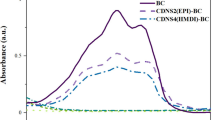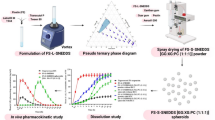Abstract
In this study, pH-sensitive nanospheres were fabricated using a polymethacrylate-based copolymer to encapsulate, protect, and release catechin, and thereby overcome its poor water solubility and low oral bioaccessibility. The polymer used was a polymethacrylic acid-co-ethyl acrylate 1:1 copolymer that dissolves above pH 5.5, and so can be used to retain and protect bioactives within the stomach but releases them in the small intestine. Catechin-loaded nanospheres were fabricated using the solvent displacement method. Physicochemical characterization of the nanospheres indicated that they were relatively small (d = 160 nm) and had a high negative charge (ζ = − 36 mV), which meant that they had good stability to aggregation under physiological conditions (pH 7.2). Catechin was trapped within the nanospheres at an encapsulation efficiency of about 51% in an amorphous state. A simulated gastrointestinal study showed that catechin was slowly released under gastric conditions (pH 2.5), but rapidly released under small intestine conditions (pH 7.2). The observed improvement in the antioxidant activity and bioaccessibility of catechin after encapsulation was attributed to the fact that it was in an amorphous state and had good water dispersibility. This study provides useful information for the formulation of novel delivery systems to improve the dispersibility, bioaccessibility, and bioactivity of catechin and potentially other active components. These delivery systems could be used to improve the efficacy of bioactive components in foods, supplements, and pharmaceutical products.









Similar content being viewed by others
Abbreviations
- Cat:
-
Catechin
- PMA:
-
Polymethacrylic acid-co-ethyl acrylate 1:1 copolymer
- NPs:
-
Nanoparticles
- NSs:
-
Nanospheres
- PMA NSs:
-
PMA nanospheres
- Cat-PMA NSs:
-
Catechin-loaded PMA nanospheres
- Eud:
-
Eudragit L30-D55
- GIT:
-
Gastrointestinal tract
- diH2O:
-
Deionized water
- rpm:
-
Revolutions per minute
- PVA:
-
Polyvinyl alcohol
- KBr:
-
Potassium bromide
- HCl:
-
Hydrochloric acid
- NaOH:
-
Sodium hydroxide
- KCl:
-
Potassium chloride
- DMSO:
-
Dimethyl sulfoxide
- PI:
-
Polydispersity index
- ζ :
-
Zeta potential
- SEM:
-
Scanning electron microscopy
- EE:
-
Drug entrapment efficiency
- DPV:
-
Differential pulse voltammetry
- DSC:
-
Differential scanning calorimetry
- XRD:
-
X-ray diffraction
- DRIFT:
-
Diffuse reflectance of infrared by Fourier transform
- mM:
-
Millimolar
- O2•− :
-
Superoxide anion radicals
- NADH:
-
β-Nicotinamide adenine dinucleotide
- NBT:
-
Nitroblue tetrazolium
- PMS:
-
Phenazine methosulfate
- SI:
-
Small intestine
- LI:
-
Large intestine
References
Acosta E (2009) Bioavailability of nanoparticles in nutrient and nutraceutical delivery. Curr Opin Colloid Interface Sci 14:3–15
Almeida H, Amaral MH, Lobão P (2012) Temperature and pH stimuli-responsive polymers and their applications in controlled and selfregulated drug delivery. J Appl Pharm Sci 2(6):1–10
Astete CE, Sabliov CM (2006) Synthesis and characterization of PLGA nanoparticles. J Biomater Sci Polym Ed 17(3):247–289
Attama A, Ezeamama U (2005) Systematic delivery of chloroquine and promethazine using pH-sensitive polymers. Drug Deliv 12(2):103–107
Babu NJ, Nangia A (2011) Solubility advantage of amorphous drugs and pharmaceutical cocrystals. Cryst Growth Des 11(7):2662–2679
Bajpai SK, Singh S (2006) Analysis of swelling behavior of poly (methacrylamide-co-methacrylic acid) hydrogels and effect of synthesis conditions on water uptake. React Funct Polym 66(4):431–440
Chugh I, Seth N, Rana AC, Gupta S (2012) Oral sustained release drug delivery system: an overview. IRJP 3(5):57–62
Das L, Bhaumik E, Raychaudhuri U, Chakraborty R (2012) Role of nutraceuticals in human health. J Food Sci Technol 49(2):173–183
des Rieux A, Fievez V, Garinot M, Schneider Y-J, Préat V (2006) Nanoparticles as potential oral delivery systems of proteins and vaccines: a mechanistic approach. J Control Release 116:1–27
Dixon SJ, Stockwell BR (2014) The role of iron and reactive oxygen species in cell death. Nat Chem Biol 10:9–17
Gaja JB, Sayyad F (2013) Preparation and evaluation of nanodispersion of telmisartan by various techniques. Inventi Journals- Inventi impact: NDDS
Gal J-Y, Fovet Y, Adib-Yadzi M (2001) About a synthetic saliva for in vitro studies. Talanta 53(6):1103–1115
Gohel DK, Jain AJ, Patel KN, Patel BA, Patel PA (2012) Formulation and evaluation of delayed release pellets of duloxetine HCl. IJPRS 1(2):421-436
Gupta S, Kesarla R, Omri A (2013) Formulation strategies to improve the bioavailability of poorly absorbed drugs with special emphasis on self-emulsifying systems. ISRN Pharm 2013:848043
Harper JK, Doebbler JA, Jacques E, Grant DM, Von Dreele RB (2010) A combined solid-state NMR and synchrotron X-ray diffraction powder study on the structure of the antioxidant (+)-catechin 4.5-hydrate. J Am Chem Soc 132(9):2928–2937
Hussain N, Jaitley V, Florence AT (2001) Recent advances in the understanding of uptake of microparticulates across the gastrointestinal lymphatics. Adv Drug Deliv Rev 50(1-2):107–142
Keane TJ, Badylak SF (2014) Biomaterials for tissue engineering applications. Semin Pediatr Surg 23(3):112–118.
Kerio L, Wachira F, Wanyoko J, Rotich M (2013) Total polyphenols, catechin profiles and antioxidant activity of tea products from purple leaf coloured tea cultivars. Food Chem 136(3–4):1405–1413
Kshirsagar S, Bhalekar M, Umap R (2009) In vitro in vivo comparison of two pH sensitive eudragit polymers for colon specific drug delivery. J Pharm Sci Res 1(4):61–70
Leung V-H, Darvell B (1997) Artificial salivas for in vitro studies of dental materials. J Dent 25(6):475–484
Li S, Li W, Khashab NM (2012) Stimuli responsive nanomaterials for controlled release applications. Nanotechnol Rev 1(6):493-513
Liu F, Ooi V, Chang S (1997) Free radical scavenging activities of mushroom polysaccharide extracts. Life Sci 60(10):763–771
Maitz MF (2015) Applications of synthetic polymers in clinical medicine. Biosurf Biotribol 1(3):161–176
Mandal B (2010) Preparation and physicochemical characterization of Eudragit® RL100 Nanosuspension with potential for ocular delivery of sulfacetamide. Doctoral dissertation, University of Toledo, Ohio
Mandal B, Alexander KS, Riga AT (2010) Sulfacetamide loaded Eudragit(R) RL100 nanosuspension with potential for ocular delivery. J Pharm Pharm Sci: Publ Can Soc Pharm Sci, Soc Can Sci Pharm 13(4):510–523
McLean JA, Karadas F, Surai PF, McDevitt RM, Speake BK (2005) Lipid-soluble and water-soluble antioxidant activities of the avian intestinal mucosa at different sites along the intestinal tract. Comp Biochem Physiol B Biochem Mol Biol 141(3):366–372
Mello VA, Ricci-Júnior E (2011) Encapsulation of naproxen in nanostructured system: structural characterization and in vitro release studies. Quim Nova 34(6):933–939
Mignani S, El Kazzouli S, Bousmina M, Majoral J-P (2013) Expand classical drug administration ways by emerging routes using dendrimer drug delivery systems: a concise overview. Adv Drug Deliv Rev 65(10):1316–1330
Mora L, Chumbimuni-Torres KY, Clawson C, Hernandez L, Zhang L, Wang J (2009) Real-time electrochemical monitoring of drug release from therapeutic nanoparticles. J Control Release 140(1):69–73
Müller RH, Gohla S, Keck CM (2011) State of the art of nanocrystals—special features, production, nanotoxicology aspects and intracellular delivery. Eur J Pharm Biopharm 78(1):1–9
Mun S, Decker EA, Park Y, Weiss J, McClements DJ (2006) Influence of interfacial composition on in vitro digestibility of emulsified lipids: potential mechanism for chitosan’s ability to inhibit fat digestion. Food Biophys 1(1):21–29
Mura S, Nicolas J, Couvreur P (2013) Stimuli-responsive nanocarriers for drug delivery. Nat Mater 12(11):991–1003
Murthy KC, Kim J, Vikram A, Patil BS (2012) Differential inhibition of human colon cancer cells by structurally similar flavonoids of citrus. Food Chem 132(1):27–34
Natu MV, de Sousa HC, Gil M (2010) Effects of drug solubility, state and loading on controlled release in bicomponent electrospun fibers. Int J Pharm 397(1):50–58
Neilson AP, Hopf AS, Cooper BR, Pereira MA, Bomser JA, Ferruzzi MG (2007) Catechin degradation with concurrent formation of homo-and heterocatechin dimers during in vitro digestion. J Agric Food Chem 55(22):8941–8949
Nguyen DN, Palangetic L, Clasen C, Van den Mooter G (2016) One-step production of darunavir solid dispersion nanoparticles coated with enteric polymers using electrospraying. J Pharm Pharmacol 68(5):625–633
Nishio S et al (2012) Long-term (> 10 years) clinical outcomes of first-in-human biodegradable poly-l-lactic acid coronary stents. Circulation 125(19):2343–2353
Noel A, Borguet YP, Raymond JE, Wooley KL (2014) Poly (ferulic acid-co-tyrosine): effect of the regiochemistry on the photophysical and physical properties en route to biomedical applications. Macromolecules 47(20):7109–7117
Parhi P, Mohanty C, Sahoo SK (2012) Nanotechnology-based combinational drug delivery: an emerging approach for cancer therapy. Drug Discov Today 17(17):1044–1052
Petru J, Zamostny P (2014) Analysis of drug release from different agglomerates using a mathematical model. Dissolut Technol 21(4):40–47
Ponnuraj R, Janakiraman K, Gopalakrishnan S, Senthilnathan K, Meganathan V, Saravanan P (2015) Formulation and characterization of epigallocatechin gallate nanoparticles. Am J Pharm Res 5:387-399
Pool H, Quintanar D, de Dios Figueroa J, Bechara JEH, McClements DJ, Mendoza S (2012a) Polymeric nanoparticles as oral delivery systems for encapsulation and release of polyphenolic compounds: impact on quercetin antioxidant activity & bioaccessibility. Food Biophys 7(3):276–288
Pool H, Quintanar D, de Dios FJ, Mano CM, Bechara JEH, Godínez LA, Mendoza S (2012b) Antioxidant effects of quercetin and catechin encapsulated into PLGA nanoparticles. J Nanomater 2012:86
Pool H, Mendoza S, Xiao H, McClements DJ (2013) Encapsulation and release of hydrophobic bioactive components in nanoemulsion-based delivery systems: impact of physical form on quercetin bioaccessibility. Food Funct 4(1):162–174
Preethi M, Prathima S, Venkata R, Sadanandam M (2011) Formulation and evaluation of duloxetine hydrochloride delayed release enteric coated capsules. IJPBS 2(3):152–172
Sassene PJ, Knopp MM, Hesselkilde JZ, Koradia V, Larsen A, Rades T, Müllertz A (2010) Precipitation of a poorly soluble model drug during in vitro lipolysis: characterization and dissolution of the precipitate. J Pharm Sci 99(12):4982–4991.
Sena LA, Chandel NS (2012) Physiological roles of mitochondrial reactive oxygen species. Mol Cell 48(2):158–167
Sharma P, Jha AB, Dubey RS, Pessarakli M (2012) Reactive oxygen species, oxidative damage, and antioxidative defense mechanism in plants under stressful conditions. J Bot 2012
Sosnik A (2014) Alginate particles as platform for drug delivery by the oral route: state-of-the-art. ISRN Pharm 2014
Tefas LR, TOMUŢĂ I, Achim M, Vlase L (2015) Development and optimization of quercetin-loaded PLGA nanoparticles by experimental design. Clujul Med 88(2):214
Tsurkan MV, Levental KR, Freudenberg U, Werner C (2010) Enzymatically degradable heparin-polyethylene glycol gels with controlled mechanical properties. Chem Commun 46(7):1141–1143
Tummala S, Satish Kumar MN, Prakash A (2015) Formulation and characterization of 5-fluorouracil enteric coated nanoparticles for sustained and localized release in treating colorectal cancer. Saudi Pharm J 23(3):308–314.
Wu T-H, Yen F-L, Lin L-T, Tsai T-R, Lin C-C, Cham T-M (2008) Preparation, physicochemical characterization, and antioxidant effects of quercetin nanoparticles. Int J Pharm 346(1):160–168
Xu X, Zhou XD, Wu CD (2011) The tea catechin epigallocatechin gallate suppresses cariogenic virulence factors of Streptococcus mutans. Antimicrob Agents Chemother 55(3):1229–1236
Yadav R, Kumar D, Kumari A, Yadav SK (2014) Encapsulation of catechin and epicatechin on BSA NPs improved their stability and antioxidant potential. EXCLI J 13:331
Yashin A, Nemzer B, Yashin Y (2012) Bioavailability of tea components. J Food Res 1(2):281
Zhang Y, Chen Y, Westerhoff P, Crittenden J (2009) Impact of natural organic matter and divalent cations on the stability of aqueous nanoparticles. Water Res 43(17):4249–4257
Zhu M, Chen Y, Li RC (2000) Oral absorption and bioavailability of tea catechins. Planta Med 66(05):444–447
Acknowledgments
The authors thank the National Council for Science and Technology (CONACYT) (Mexico) for scholarship granted. Also, we would like to thank Araceli Mauricio, José Eleazar, and Luz María Aviles for the technical support of DRIFT, SEM, and zeta potential analyses, respectively.
Funding
This work received financial support from the US Department of Agriculture, CREES, NRI and AFRI Grants, and Massachusetts Department of Agricultural Resources.
Author information
Authors and Affiliations
Corresponding author
Ethics declarations
Conflict of interest
The authors declare that they have no conflict of interest.
Rights and permissions
About this article
Cite this article
Pool, H., Luna-Barcenas, G., McClements, D.J. et al. Development of polymethacrylate nanospheres as targeted delivery systems for catechin within the gastrointestinal tract. J Nanopart Res 19, 324 (2017). https://doi.org/10.1007/s11051-017-4007-3
Received:
Accepted:
Published:
DOI: https://doi.org/10.1007/s11051-017-4007-3




